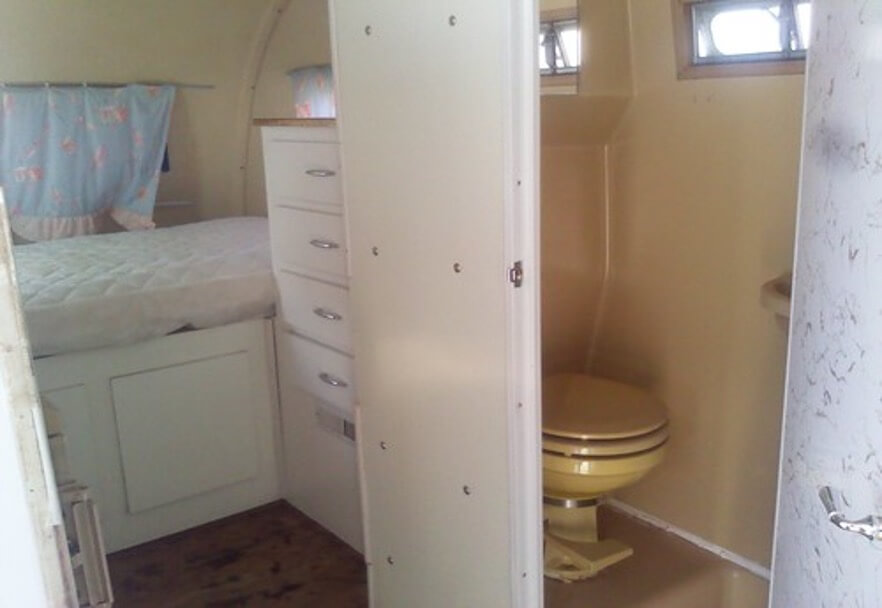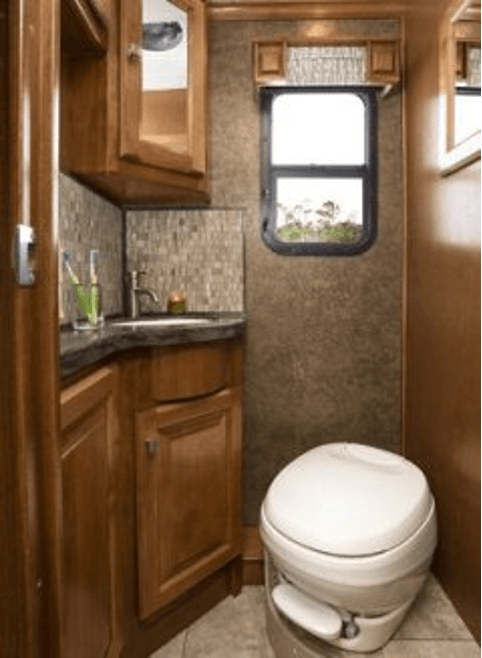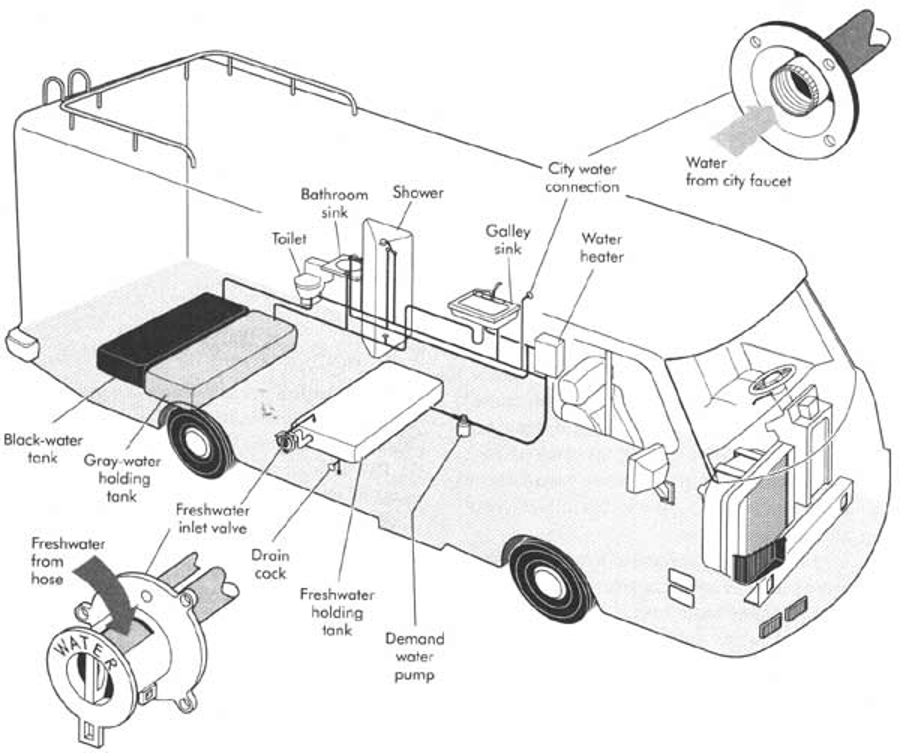
RV Bathrooms are pretty like the bathrooms at your home. The key difference is that the RV bathrooms store waste in the holding tanks (black and gray tanks) until it is dumped, whereas, at home bathrooms, the waste directly passes to the sewer system. Moreover, while using RV bathrooms, you should be extra careful because a large amount of dump can cause the tanks (both black and gray tanks) to malfunction.
That said, your RV bathroom is equipped with holding tanks, plumbing, and ventilation for containing bathroom-related waste until you dump it at a dumping station or into a sewer system. The water for the sink, shower and toilet of an RV bathroom is brought in through a hose that connects to the water intake connection on the outside of the RV.
There are two kinds of holding tanks, a black tank and a gray tank. Water and waste from toilets are collected in the black tank, while water and waste from sinks and bathtubs are collected in the gray tank, and they also have ventilation systems that pull air through it and release it outside the RV. RV safe toilet paper is specially designed to break down quickly, preventing clogs and protecting your vehicle’s septic system.

How Do RV Showers Work?
An RV bathroom includes a sink, shower, and toilet. Most RVs do come with a shower, but tiny RVs might not have a shower. The size of the shower depends on the size of the RV. Taking a shower in your RV is not as rejuvenating as taking a shower in your home bathroom. You will have very little elbow room and place for your toiletries. Sometimes, you may even feel claustrophobic, considering how congested it would be.
How Long Can You Shower in Your RV?
You can take a long shower if you are at a campground with full hookups, a tankless water heater, and an uncapped gray water tank. If you don’t have access to these things, a quick 5–10-minute shower is advised.
How Many Gallons of Water Do You Need to Shower in an RV?
Several factors affect this, including how long you shower, what type of shower head is used, and whether you turn off the shower while lathering. In general, a shower won’t take more than 2-6 gallons of water.
How Do RV Water Heaters Work?
Although RV water heaters are very similar to the water heaters at home bathrooms, they are comparatively small. In RV water heaters, there are a maximum of three methods to heat the water. And you will also need to plan accordingly when to turn the water heater on and when to turn it off.

How To Maintain the Holding Tanks?
The Gray water holding tank can be kept open if the RV is hooked up to the sewer connection at the campgrounds or dump stations. Strictly keep it closed if the RV is not hooked up to a sewer connection. The Gray holding tank gets full quickly when you shower in the RV bathroom, so go empty the tank at the dump station when it is 2/3rd full. Every month, put a treatment product in the gray water tank through the sink to clean the tank and prevent odors.
Unlike the Gray water holding tank, the black water holding tank needs to be always kept closed, even if it is connected to the sewer system. There should always be a treatment product in the black tank to assist with toilet paper breakdown and prevent odors. The Black tank should not be emptied until 3/4th full since a fuller tank flow through the sewer faster, helping to empty it sooner fully.
For emptying the tank, connect one end of the sewer hose to the sewer connection on the outside of the RV and the other end to the connection to the dump station. Note that the black water tank must be emptied first to ensure the gray water cleans out the sewer hoses. Once the sewer hoses are connected, open the valve of the black tank.
Then, allow the toilet water to empty into the sewer. Once it is empty, close the valve. Then, open the valve of the gray tank, and allow the sink and shower water to flow through the sewer tube to the sewer. The Gray water will also clean any remaining water in the black tank from the sewer tube. Once you see and hear that the tank is empty, close the valve, and disconnect the sewer hose from both connections.
How Often to Empty the Tanks?
The waste needs to be dumped before it overflows and causes stinky problems in your RV. The Gray tank usually needs to be dumped before it is 2/3rd full, and the black tank, when it reaches the 3/4th mark. Some otherwise suggest getting the tank as full as possible to flush out the solids better.
Ample Amount of Water: Good or Bad?
Note that using an ample amount of water is good. It will ensure that you are maintaining a consistent water level to allow your tank treatment to reach all the waste in your tank, and it will also prevent strong odors.
How To Keep Your RV Bathroom Clean and Fresh?
- Use RV toilet chemicals. There are several chemicals designed specifically for RV toilets, which help neutralize odors and break down the solid waste and toilet tissue for easy dumping. You can use them whenever you empty your toilet tanks and whenever your bathroom needs a refreshment.
- Use sustainable and easily breakable toilet paper. Regular toilet paper usually leads to clogs as it doesn’t break down easily. And you know how much harm a clog in the toilet or the tank can cause your RV – unpleasant odors, for example.
- Maintain a regular tank dump schedule, and ensure you wash it thoroughly from time to time. Make sure that the valves are closed when connected to the sewer system; if not, an open connection can cause various problems.
- Make sure your bathroom vent fan is turned off before flushing. Most camper bathrooms have exhaust vents with fans located above the toilet. This is mostly to reduce odors. But it is recommended to close the vent and turn off the fan before flushing as open vents create an updraft, sucking odors and fumes directly from your exposed black water tank. You can imagine what it would result in, so it is better to close it before flushing.
- Make sure it’s clean! I am sure you would read this everywhere, but isn’t it the key to maintaining anything for a long time? Keep your RV bathroom clean so that it doesn’t smell bad, clog, or even worse, cause you to get sick. Like how you probably clean your home bathroom often, do the same in your RV bathrooms too. Scrub your toilet and bleach all the bathroom surfaces, clean the holding tank, and rest assured your RV bathroom will not cause you any trouble during your camping.
Therefore, as mentioned above, there are only a few differences between the RV bathrooms and the bathrooms at home, but it is quite similar when it comes to how it needs to be maintained. By maintaining it right, you will soon find comfort even in your RV bathroom.

